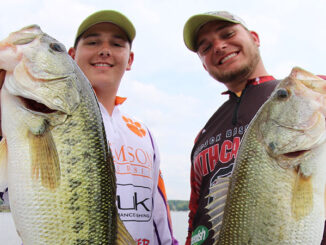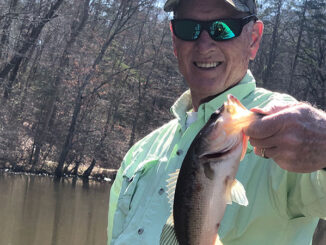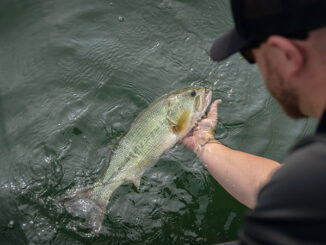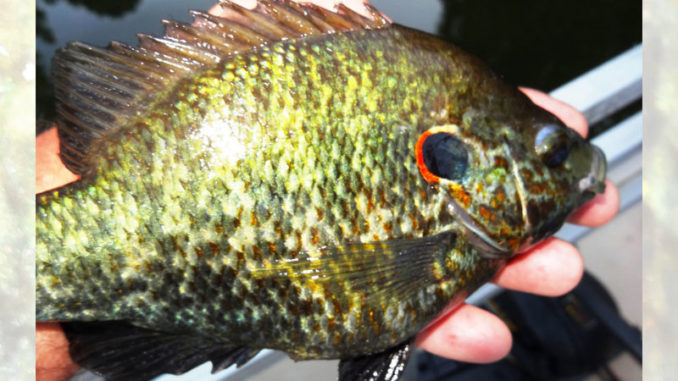
Shellcrackers, stripers, bass are in full-on feed
With warming water temperatures, the spawning urge heightens for multiple species, and an influx of high-quality forage such as herring into the shallows creates ideal shallow water opportunities.
Shallow shellcrackers
Lake Marion and Lake Moultrie harbor some of the best shellcracker fishing in the world, and these huge panfish often begin spawning earlier than bluegills. When weather and water conditions are ideal, they’ll sometimes begin to bed in March. But by April they are typically spawning throughout the lakes.
Shellcrackers have a tendency to spawn very shallow. Occasionally, anglers won’t search quite shallow enough. They prefer sandy, gravel bottoms and often get in water so shallow their fins are barely covered. With water conditions normal, the beds can often be seen.
The best technique is to use a lightweight, 10- to 12-foot pole with some backbone near the butt, get into the cypress swamps and fish along the edges of grassbeds and around the trees, stumps and logs. While working the grass or pad edges, flip your bait into any hole or pocket back in the weedy growth. Shellcrackers will often bed back in the weeds when spawning. If you catch a shellcracker along a weedy edgeline, don’t move on without working nearby shallower water.
The bait of choice for experienced Santee Cooper shellcracker fishermen is a red worm. Some thread them onto the hook and use it as a single, wiggling morsel. Others hook a couple of worms in the middle to leave multiple ends dangling. Shellcrackers will take either, but on some days, one may work better than the other.
Most shellcracker experts recommend using a slip float so depths can be adjusted quickly and work the shallows until you find the beds. Fish until the action slows and repeat the process.
Stripers on the move
Stripers will begin their spawning migration during March. But April is typically the time when fish really begin to flood into the upper reaches of Lake Marion.
A large area of the Santee River in upper Lake Marion offers potentially great action. The area from Packs Landing up and down the river channel, are prime spots to target. Stripers are migrating upstream on their spawning run and are more accessible when confined in the main run of Santee River channel and also far up both the Congaree and Wateree rivers.
According to guide Steve Pack at Packs Landing, stripers tend to move up the river. They’ll typically be found along the edge of the channel.
“We’ll anchor on bends in the river and along shallow shoals that drop into the deeper water,” he said. “Typically, we’ll have plenty of current. So we’ll cast our rigs downstream and give the fish 20 to 30 minutes at each area. Sometimes, we’ll catch a few, then have to move. But some days the action remains steady all morning from a single spot. It’s a pattern we have to determine daily.”
Pack (803-452-5514) said fishing holes and drops in the flats will sometimes produce as well. The bait of choice for stripers is the big herring that migrate into the lakes every spring.
“A bonus when fishing the herring, live or cut, is we catch some huge catfish,” he said. “We’re targeting stripers, but by fishing herring on and near the bottom, we get plenty of catfish bites. And some of the fish are huge.”
Wild, shallow bass
By April, largemouth bass are literally in prespawn, spawn and postspawn modes, meaning a wide diversity of cover can be productive. The common denominator for all three patterns is the action is in shallow water.
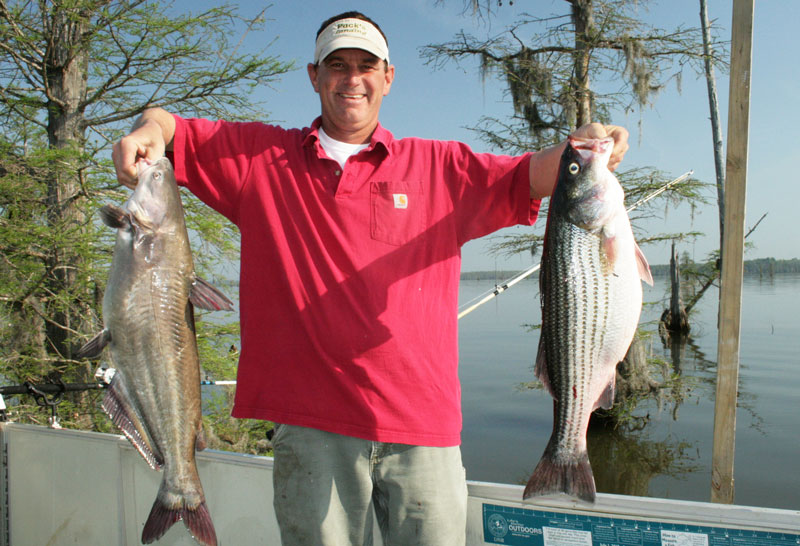
Guide Brett Mitchell, who works out of Blacks Camp, said it’s likely that more bass are active in shallow water than at any other time of the year.
“With the diversity of patterns during April, the opportunity to target (your) favorite type of fishing is excellent,” he said. “Anglers can work any lure from topwaters to bottom bumpers and everything in between and find bass willing to bite.”
Mitchell (803-379-7029) said he’ll cover a lot of water during April. Cypress and gum trees, weed edges, depressions and flooded ditches that course through shallow flats are all potentially productive.
“With plenty of bass still bedding this month, the potential for huge fish is still excellent,” he said. “But we’ll also have some great action on staging prespawn fish and postspawn bass roaming the shallows.”

